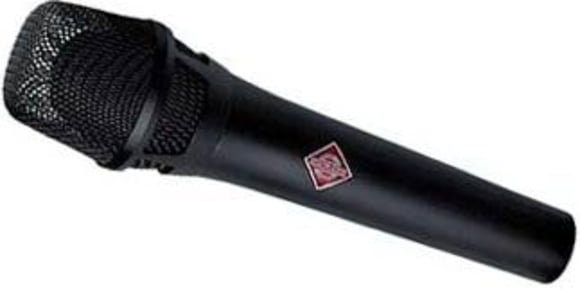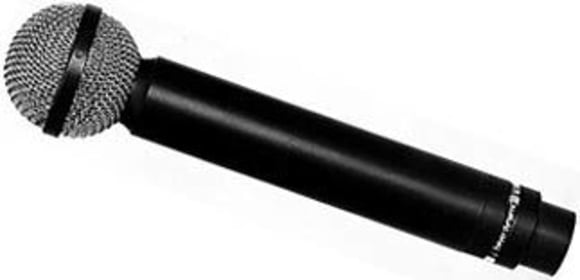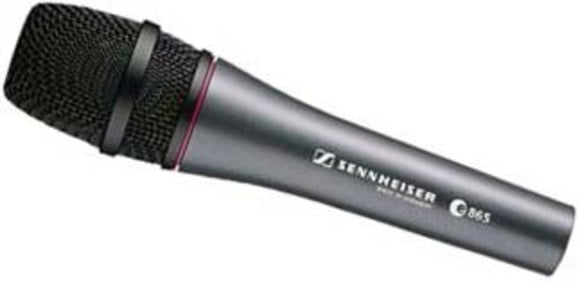3. Microphone Designs
There are three main transducer types used by microphones to convert sound waves into electrical signals, commonly known as dynamic, condenser and ribbon:
Dynamic

The dynamic microphone is the most basic type, and usually the least expensive, and this is one of the reasons that it is often the most popular choice of singers on stage. Inside the mic is a small, thin plastic membrane or diaphragm that moves in response to audio waves. When the diaphragm moves back and forth, an attached coil moves within a magnetic field, which in turn generates an electrical current in the wire of the coil. Since the mass of the diaphragm and the voice coil is actually quite large compared to the energy thats contained in the acoustic signal, it takes time for the diaphragm to respond to the signal, restricting how fast it can move this is inertia at work if you remember your school physics lessons! For this reason, dynamic mics tend to respond poorly to high frequencies by comparison with other microphone types, however this is not usually too much of a problem with stage vocals, where detail of sound is not as important as in the studio, and its less sensitive design is also less prone to picking up handling noise. It also suits the need for reliability and ruggedness, as dynamics tend to be substantially more robust than other microphones types, and they have the added benefit of not requiring a source of electrical power.
Condenser
The heart of a condenser or capacitor microphone is a pair of metal plates placed in parallel to each other, spaced at a distance of about two hundredths of a millimetre. One plate is fixed, and the other is a diaphragm which is free to move in sympathy with incoming sound waves. When the spacing between the plates changes, the capacitance varies - remember those physics classes again! If a polarising voltage is placed across the capsule, a small electrical signal is then produced which describes the sound wave.

The electrical signal produced is much smaller than that of a dynamic mic, which is why a built-in pre-amplifier is required to bring the signal up to normal microphone level this should not be confused with external mic pre-amps, which are used to bring mic level signals up to line level. Because of the built-in pre-amp, and also the requirement for a polarising voltage, condenser mics need a source of electrical power this normally comes in the form of phantom power, which is a back voltage supplied up the cable by the (external) mic pre-amp, although some cheaper models with pre-polarised capsules (see Electret) can also run on batteries. Condenser mics that use valves for their internal pre-amps need a separate power supply, as phantom power cant supply the necessary current.
Although the condenser has an extended frequency response and should therefore generally sound better than a dynamic, its not necessarily the best choice for singing on stage where the difference in quality may not be all that noticeable, but the difference in price might! Extended frequency response can also make condensers more prone to feedback. A number of manufacturers do design condensers specifically for stage use though, and these typically have the ruggedness and handling capability of their dynamic counterparts. So for more intimate venues, and when the style of music is more suited to benefiting from the sound quality of a condenser, this might be the best microphone type for the job. Condensers are particularly flattering to more delicate female vocals.
Ribbon
Ribbon mics are actually a special case of the dynamic mic rather than a coil attached to a separate diaphragm, they use a very thin metal ribbon as a diaphragm. This is suspended between two magnets, and its movement in sympathy with sound waves produces an electrical signal, in much the same way as a regular dynamic. Due to the ribbons very low mass however, their high frequency response is more comparable to that of a condenser.

Although they are loved for their warm sound, ribbon mics do have some disadvantages, and so are generally not the first choice for a live microphone due to the fragile nature of the design, though companies such as Beyer and Royer produce a number of ribbon microphones for stage use. As they are less popular and fewer models of this type of design are available, the cost tends to be higher than an equivalent condenser or dynamic, and they are generally more fragile still than a condenser. As such, theyre only recommended for live use if you absolutely must have that ribbon sound.
Electret
Electret mics work on a similar principle to the condenser, the main difference being that the electrical charge is not provided by an external power supply, but rather the mic itself. Electret mics originally used a diaphragm made from an insulating material that had a permanent electrical charge. A pre-amplifier was still needed, but this could be built very cheaply and could run from phantom power, or in some cases a battery. Because the diaphragms had to be quite heavy in order to carry the permanent electrical charge, they offered no real advantage over a dynamic mic in terms of frequency response or dynamic range, and so the design was improved - the permanently charged material was fixed to the stationary back-plate rather than the diaphragm, hence the term back electret. In this way, much thinner diaphragms could be employed, made of the same metal-coated plastic material as with a true condenser model. This reduced the cost of manufacture and somewhat extended the freedom of application, since electret mics can be very light and small in size. A low voltage supply is still needed for the amplifier, but the need for the high voltage polarising source is eliminated, and so electrets usually run on batteries rather than phantom power.

This type of design is a good compromise, in that it can have the sound quality of a condenser, but is more rugged and cheaper to manufacture. The electret design was originally responsible for making quality vocal microphones much cheaper to buy, before manufacturing in the Far East contributed to further price reductions. Their high sensitivity enables them to usefully capture sound at greater distance, and so theyre often chosen for choirs or orchestras, but they can be equally well used for vocalists on stage.






